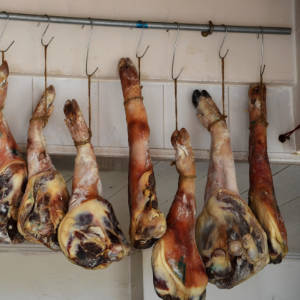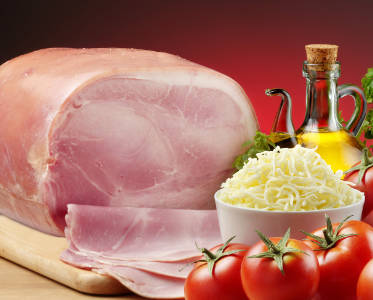Ham Category

A ham is a pork cut that's taken from a hog's upper hind leg. There are three types of American hams: city hams, country hams, and fresh hams. City hams are the most common. They're soaked in brine (or injected with it) and then boiled or lightly smoked. Many gourmets prefer country hams, which are dry-cured and then smoked and aged for added flavor. Fresh hams aren't cured at all and need to be cooked.
America also imports several dry-cured hams from abroad, including prosciutto, Bayonne ham, Serrano ham, Black Forest ham, Westphalian ham, York ham, and Ardennes ham. These hams are similar to our country hams, except that they're often eaten raw while country hams are usually served cooked.
Ham is relatively low in fat, but even low-salt hams are high in sodium.
Black Forest ham
This moist German ham is smoked over pine and fir, and coated with beef blood to give it a black exterior.
Learn morecanned ham
These are boneless hams that are sealed in a can and then cooked. They're not as flavorful as other kinds of ham, and they have a higher moisture content, which makes them more perishable. Store the unopened can in the refrigerator until you're ready to use it, and use leftovers within a week.
Learn moreChinese ham
This category includes the well-regarded Yunnan ham = Xuanwei ham. Chinese hams are dry-cured and resemble American country hams.
Learn morecity ham
This is America's most popular ham, the kind that's pink, moist, and sweet. Fresh hams are soaked in brine (or injected with it) and then boiled or lightly smoked. Boneless hams = boned hams are easier to carve, but they're not as flavorful or attractive as bone-in hams. A good compromise is to buy a bone-in spiral-sliced ham, which combines good flavor and convenience, or a ham steak (pictured at right). City hams usually come fully cooked (check the label), but most people reheat them before serving.
Learn morecountry ham
These are made by rubbing salt over a fresh ham and then hanging it out to dry. They're often smoked as well. They tend to be salty, but gourmets often prefer them over city hams. You cook them either by simmering them in water or frying them. Some people soak them in water first to leech out some of the salt. Mold often forms on country hams, but it's harmless and should simply be scrubbed off. Country hams are common in the Southeast; elsewhere you can get them by mail order, or at Chinese markets. Varieties include Virginia ham and Smithfield ham.
Learn moreculatello
This expensive, dry-cured red ham hails from Parma. It's usually sliced paper-thin and served like prosciutto. It's hard to find in the United States.
Learn moredeviled ham
This is a dip or sandwich spread made with chopped ham, sour cream, and various seasonings.
Learn morehalf ham
Whole hams are too large for many families to handle, so manufacturers often cut them in half. The butt half = butt end is higher up on the hog, and is meatier, fattier, easier to carve, and more expensive. The shank half = shank end = hock half = hock end is leaner and, some say, sweeter.
Learn moreham
A ham is a pork cut that's taken from a hog's upper hind leg. There are three types of American hams: city hams, country hams, and fresh hams. City hams are the most common. They're soaked in brine (or injected with it) and then boiled or lightly smoked. Many gourmets prefer country hams, which are dry-cured and then smoked and aged for added flavor. Fresh hams aren't cured at all and need to be cooked. America also imports several dry-cured hams from abroad, including prosciutto, Bayonne ham, Serrano ham, Black Forest ham, Westphalian ham, York ham, and Ardennes ham. These hams are similar to our country hams, except that they're often eaten raw while country hams are usually served cooked. Ham is relatively low in fat, but even low-salt hams are high in sodium.
Learn morekassler rippchen
German delis sometimes stock these pre-sliced smoked pork chops. They're fully cooked.
Learn morelachsschinken
This dry-cured smoked pork loin is wrapped in a thin layer of fat. It hails from Bavaria.
Learn morepicnic ham
This is cured like a ham, but cut from the hog's shoulder. It's not as tender and lean as a true ham, and it cooks much quicker. It's a good, inexpensive choice if you want chopped ham for soups and casseroles.
Learn moreprosciutto
Prosciutto hails from Italy and is reknown for its delicate, salty flavor. It's usually cut into paper thin slices and served raw. Especially well regarded is Parma ham, which comes from Parma in Italy. Select a prosciutto that's shiny and deeply colored.
Learn moreschinkenspeck
A German specialty, schinkenspeck is lean pork that's been dry-cured and aged. It's normally sliced paper-thin and served cold.
Learn moreSerrano ham
This Spanish dry-cured ham doesn't need to be cooked before eating. It's not smoked, and it's usually cut into very thin slices.
Learn moresliced ham
Sliced ham is moister than other kinds of ham, which makes it far more perishable. Store it in the refrigerator and use it within a few of days after buying it.
Learn moresmoked hog jowl
The jowl (which is pronounced "jole" in the South) is the hog's cheek. It's often cut into pieces and used to flavor stews, collard greens, and bean dishes.
Learn moretasso
This is a heavily smoked ham with a spicy, peppery rind. It's often used in Cajun dishes.
Learn moreWestphalian ham
This choice German ham is smoked over beechwood and juniper and has a salty, smoky flavor. It's usually cut into very thin slices and eaten raw.
Learn moreYork ham
This is a lightly smoked, dry-cured British ham. It's saltier but milder in flavor than other European dry-cured hams.
Learn more



























































































































































































































































































































































